Process Studies of the Impact of Land-Surface Resolution on Convective Precipitation Based on High-Resolution ICON Simulations
Abstract
:1. Introduction
2. Methodology
2.1. Investigation Areas and Selected Cases
2.2. Model Setup and Simulation Strategy
2.3. Analysis Tools
3. Results
3.1. Areal Means in Dependence of Land-Surface Resolution
3.2. Processes Causing Convective Precipitation in Dependence on Land-Surface Resolution over an Isolated Mountain Range
3.2.1. Reference Run—First Precipitation Event
3.2.2. Differences of the Sensitivity Run to the Reference Run
3.2.3. Reference Run—Second Precipitation Event
3.3. Processes Causing Convective Precipitation in Dependence on Land-Surface Resolution over Complex Terrain
3.3.1. Reference Run
3.3.2. Differences of the Sensitivity Run to the Reference Run
4. Summary
Author Contributions
Funding
Institutional Review Board Statement
Informed Consent Statement
Data Availability Statement
Acknowledgments
Conflicts of Interest
References
- Weckwerth, T.M.; Parsons, D.B. A review of convection initiation and motivation for IHOP_2002. Mon. Weather Rev. 2006, 134, 5–22. [Google Scholar] [CrossRef]
- Bennett, L.J.; Browning, K.A.; Blyth, A.M.; Parker, D.J.; Clark, P.A. A review of the initiation of precipitating convection in the United Kingdom. Q. J. R. Meteorol. Soc. 2006, 132, 1001–1020. [Google Scholar] [CrossRef]
- Kirshbaum, D.J.; Adler, B.; Kalthoff, N.; Barthlott, C.; Serafin, S. Moist orographic convection: Physical mechanisms and links to surface-exchange processes. Atmosphere 2018, 9, 80. [Google Scholar] [CrossRef] [Green Version]
- Schneider, L.; Barthlott, C.; Barrett, A.I.; Hoose, C. The precipitation response to variable terrain forcing over low mountain ranges in different weather regimes. Q. J. R. Meteorol. Soc. 2018, 144, 970–989. [Google Scholar] [CrossRef]
- Heim, C.; Panosetti, D.; Schlemmer, L.; Leuenberger, D.; Schär, C. The influence of the resolution of orography on the simulation of orographic moist convection. Mon. Weather Rev. 2020, 148, 2391–2410. [Google Scholar] [CrossRef] [Green Version]
- Schädler, G. Triggering of atmospheric circulations by moisture inhomogeneities of the earth’s surface. Bound.-Layer Meteorol. 1990, 51, 1–29. [Google Scholar] [CrossRef]
- Segal, M.; Arritt, R. Nonclassical mesoscale circulations caused by surface sensible heat-flux gradients. Bull. Am. Meteorol. Soc. 1992, 73, 1593–1604. [Google Scholar] [CrossRef] [Green Version]
- Taylor, C.M.; Parker, D.J.; Harris, P.P. An observational case study of mesoscale atmospheric circulations induced by soil moisture. Geophys. Res. Lett. 2007, 34, L15801. [Google Scholar] [CrossRef] [Green Version]
- Kottmeier, C.; Kalthoff, N.; Barthlott, C.; Corsmeier, U.; Van Baelen, J.; Behrendt, A.; Behrendt, R.; Blyth, A.; Coulter, R.; Crewell, S.; et al. Mechanisms initiating deep convection over complex terrain during COPS. Meteorol. Z. 2008, 17, 931–948. [Google Scholar] [CrossRef] [Green Version]
- Kalthoff, N.; Adler, B.; Barthlott, C.; Corsmeier, U.; Mobbs, S.; Crewell, S.; Träumner, K.; Kottmeier, C.; Wieser, A.; Smith, V.; et al. The impact of convergence zones on the initiation of deep convection: A case study from COPS. Atmos. Res. 2009, 93, 680–694. [Google Scholar] [CrossRef]
- Klüpfel, V.; Kalthoff, N.; Gantner, L.; Taylor, C.M. Convergence zones and their impact on the initiation of a mesoscale convective system in West Africa. Q. J. R. Meteorol. Soc. 2012, 138, 950–963. [Google Scholar] [CrossRef] [Green Version]
- Schlemmer, L.; Hohenegger, C. The formation of wider and deeper clouds as a result of cold-pool dynamics. J. Atmos. Sci. 2014, 71, 2842–2858. [Google Scholar] [CrossRef] [Green Version]
- Hirt, M.; Craig, G.C.; Schäfer, S.A.; Savre, J.; Heinze, R. Cold-pool-driven convective initiation: Using causal graph analysis to determine what convection-permitting models are missing. Q. J. R. Meteorol. Soc. 2020, 146, 2205–2227. [Google Scholar] [CrossRef]
- Clark, D.B.; Taylor, C.M.; Thorpe, A.J. Feedback between the land surface and rainfall at convective length scales. J. Hydrometeorol. 2004, 5, 625–639. [Google Scholar] [CrossRef]
- Barthlott, C.; Kalthoff, N. A numerical sensitivity study on the impact of soil moisture on convection-related parameters and convective precipitation over complex terrain. J. Atmos. Sci. 2011, 68, 2971–2987. [Google Scholar] [CrossRef]
- Adler, B.; Kalthoff, N.; Gantner, L. Initiation of deep convection caused by land-surface inhomogeneities in West Africa: A modelled case study. Meteorol. Atmos. Phys. 2011, 112, 15–27. [Google Scholar] [CrossRef]
- Hohenegger, C.; Schlemmer, L.; Silvers, L. Coupling of convection and circulation at various resolutions. Tellus A 2015, 67, 26678. [Google Scholar] [CrossRef] [Green Version]
- Panosetti, D.; Böing, S.; Schlemmer, L.; Schmidli, J. Idealized large-eddy and convection-resolving simulations of moist convection over mountainous terrain. J. Atmos. Sci. 2016, 73, 4021–4041. [Google Scholar] [CrossRef]
- Liu, S.; Shao, Y.; Kunoth, A.; Simmer, C. Impact of surface-heterogeneity on atmosphere and land-surface interactions. Environ. Model. Softw. 2017, 88, 35–47. [Google Scholar] [CrossRef]
- Heinze, R.; Dipankar, A.; Henken, C.C.; Moseley, C.; Sourdeval, O.; Trömel, S.; Xie, X.; Adamidis, P.; Ament, F.; Baars, H.; et al. Large-eddy simulations over Germany using ICON: A comprehensive evaluation. Q. J. R. Meteorol. Soc. 2017, 143, 69–100. [Google Scholar] [CrossRef] [Green Version]
- Stevens, B.; Acquistapace, C.; Hansen, A.; Heinze, R.; Klinger, C.; Klocke, D.; Rybka, H.; Schubotz, W.; Windmiller, J.; Adamidis, P.; et al. The added value of large-eddy and storm-resolving models for simulating clouds and precipitation. J. Meteorol. Soc. Jpn. 2020, 98, 395–435. [Google Scholar] [CrossRef] [Green Version]
- Weisman, M.L.; Skamarock, W.C.; Klemp, J.B. The resolution dependence of explicitly modeled convective systems. Mon. Weather Rev. 1997, 125, 527–548. [Google Scholar] [CrossRef]
- Honnert, R. Representation of the grey zone of turbulence in the atmospheric boundary layer. Adv. Sci. Res. 2016, 13, 63–67. [Google Scholar] [CrossRef]
- Wyngaard, J.C. Toward numerical modeling in the “Terra Incognita”. J. Atmos. Sci. 2004, 61, 1816–1826. [Google Scholar] [CrossRef]
- Honnert, R.; Efstathiou, G.A.; Beare, R.J.; Ito, J.; Lock, A.; Neggers, R.; Plant, R.S.; Shin, H.H.; Tomassini, L.; Zhou, B. The Atmospheric Boundary Layer and the “Gray Zone” of Turbulence: A critical review. J. Geophys. Res. 2020, 125, e2019JD030317. [Google Scholar] [CrossRef]
- Zhou, B.; Simon, J.S.; Chow, F.K. The convective boundary layer in the terra incognita. J. Atmos. Sci. 2014, 71, 2545–2563. [Google Scholar] [CrossRef]
- Chow, F.K.; Weigel, A.P.; Street, R.L.; Rotach, M.W.; Xue, M. High-resolution large-eddy simulations of flow in a steep Alpine valley. Part I: Methodology, verification, and sensitivity experiments. J. Appl. Meteorol. Climatol. 2006, 45, 63–86. [Google Scholar] [CrossRef] [Green Version]
- Barthlott, C.; Hoose, C. Spatial and temporal variability of clouds and precipitation over Germany: Multiscale simulations across the “gray zone”. Atmos. Chem. Phys. 2015, 15, 12361–12384. [Google Scholar] [CrossRef] [Green Version]
- Singh, S. Convective Precipitation Simulated with ICON over Heterogeneous Surfaces in Dependence on Model and Land-Surface Resolution; Karlsruhe Institute of Technology (KIT) Scientific Publishing: Karlsruhe, Germany, 2021; p. 200. [Google Scholar] [CrossRef]
- Zängl, G.; Reinert, D.; Rípodas, P.; Baldauf, M. The ICON (ICOsahedral Non-hydrostatic) modelling framework of DWD and MPI-M: Description of the non-hydrostatic dynamical core. Q. J. R. Meteorol. Soc. 2015, 141, 563–579. [Google Scholar] [CrossRef]
- Dipankar, A.; Stevens, B.; Heinze, R.; Moseley, C.; Zängl, G.; Giorgetta, M.; Brdar, S. Large eddy simulation using the general circulation model ICON. J. Adv. Model. Earth Syst. 2015, 7, 963–986. [Google Scholar] [CrossRef] [Green Version]
- Bartels, H.; Weigl, E.; Reich, T.; Lang, P.; Wagner, A.; Kohler, O.; Gerlach, N. Projekt RADOLAN–Routineverfahren zur Online-Aneichung der Radarniederschlagsdaten mit Hilfe von automatischen Bodenniederschlagsstationen (Ombrometer). Dtsch. Wetterdienst, Hydrometeorol. 2004, 5. [Google Scholar]
- Berrisford, P.; Dee, D.; Poli, P.; Brugge, R.; Fielding, K.; Fuentes, M.; Kallberg, P.; Kobayashi, S.; Uppala, S.; Simmons, A. The ERA-Interim archive, version 2.0. ERA Rep. Ser. 2011, 1, 23. Available online: https://www.ecmwf.int/node/8174 (accessed on 10 May 2022).
- Dee, D.P.; Uppala, S.M.; Simmons, A.; Berrisford, P.; Poli, P.; Kobayashi, S.; Andrae, U.; Balmaseda, M.; Balsamo, G.; Bauer, d.P.; et al. The ERA-Interim reanalysis: Configuration and performance of the data assimilation system. Q. J. R. Meteorol. Soc. 2011, 137, 553–597. [Google Scholar] [CrossRef]
- Schulz, W.; Diendorfer, G.; Pedeboy, S.; Poelman, D.R. The European lightning location system EUCLID–Part 1: Performance analysis and validation. Nat. Hazards Earth Syst. Sci. 2016, 16, 595–605. [Google Scholar] [CrossRef] [Green Version]
- Schrodin, R.; Heise, E. The Multi-Layer Version of the DWD Soil Model TERRA_LM; COSMO Technical Report No. 2; Deutscher Wetterdienst (DWD): Offenbach, Germany, 2001. [Google Scholar] [CrossRef]
- Heise, E.; Ritter, B.; Schrodin, R. Operational implementation of the multilayer soil model. Consort. Small-Scale Model. (COSMO) Tech. Rep. 2006, 9, 20. [Google Scholar]
- Raschendorfer, M. The new turbulence parameterization of LM. Proc. Cosmo Newsl. 2001, 1, 89–97. Available online: http://www.cosmo-model.org/content/model/documentation/newsLetters/newsLetter01/newsLetter_01.pdf (accessed on 10 May 2022).
- Lilly, D.K. On the numerical simulation of buoyant convection. Tellus 1962, 14, 148–172. [Google Scholar] [CrossRef]
- Honnert, R.; Masson, V. What is the smallest physically acceptable scale for 1D turbulence schemes? Front. Earth Sci. 2014, 2, 27. [Google Scholar] [CrossRef] [Green Version]
- Cuxart, J. When can a high-resolution simulation over complex terrain be called LES? Front. Earth Sci. 2015, 3, 87. [Google Scholar] [CrossRef] [Green Version]
- DWD-PAMORE. PArallel MOdel Data REtrieve from Oracle Databases (PAMORE); Deutscher Wetterdienst (DWD): Offenbach, Germany, 2015. [Google Scholar]
- Singh, S.; Kalthoff, N.; Gantner, L. Sensitivity of convective precipitation to model grid spacing and land-surface resolution in ICON. Q. J. R. Meteorol. Soc. 2021, 147, 2709–2728. [Google Scholar] [CrossRef]
- Asensio, H.; Messmer, M.; Lüthi, D.; Osterried, K. External Parameters for Numerical Weather Prediction and Climate Application EXTPAR v5_0. User and Implementation Guide. 2020. Available online: http://www.cosmo-model.org/content/support/software/ethz/EXTPAR_user_and_implementation_manual_202003 (accessed on 10 May 2022).
- Prill, F. DWD ICON Tools Documentation; Deutscher Wetterdienst (DWD): Offenbach, Germany, 2014. [Google Scholar]
- Siegel, A. Practical Business Statistics; Academic Press: Cambridge, MA, USA, 2016; ISBN 978-0-12-811175-8. [Google Scholar]
- Wernli, B.H.; Davies, H.C. A Lagrangian-based analysis of extratropical cyclones. I: The method and some applications. Q. J. R. Meteorol. Soc. 1997, 123, 467–489. [Google Scholar] [CrossRef]
- Sprenger, M.; Wernli, H. The Lagrangian analysis tool LAGRANTO-version 2.0. Geosci. Model Dev. Discuss. 2015, 8, 1893–1943. [Google Scholar] [CrossRef] [Green Version]
- Stull, R.B. An Introduction to Boundary Layer Meteorology; Kluwer Academic Publication: Dordrecht, The Netherlands, 1988; Volume 13, ISBN 978-9-02-772769-5. [Google Scholar]
- Grams, C.M.; Jones, S.C.; Marsham, J.H.; Parker, D.J.; Haywood, J.M.; Heuveline, V. The Atlantic inflow to the Saharan heat low: Observations and modelling. Q. J. R. Meteorol. Soc. 2010, 136, 125–140. [Google Scholar] [CrossRef]
- Bradski, G.; Kaehler, A. Learning OpenCV: Computer Vision with the OpenCV Library; O’Reilly Media, Inc.: Sebastopol, CA, USA, 2008; ISBN 978-0-59-651613-0. [Google Scholar]
- White, B.; Buchanan, A.; Birch, C.; Stier, P.; Pearson, K. Quantifying the effects of horizontal grid length and parameterized convection on the degree of convective organization using a metric of the potential for convective interaction. J. Atmos. Sci. 2018, 75, 425–450. [Google Scholar] [CrossRef] [Green Version]
- Smith, R.B. Hydrostatic airflow over mountains. In Advances in Geophysics; Elsevier: Amsterdam, The Netherlands, 1989; Volume 31, pp. 1–41. [Google Scholar] [CrossRef]
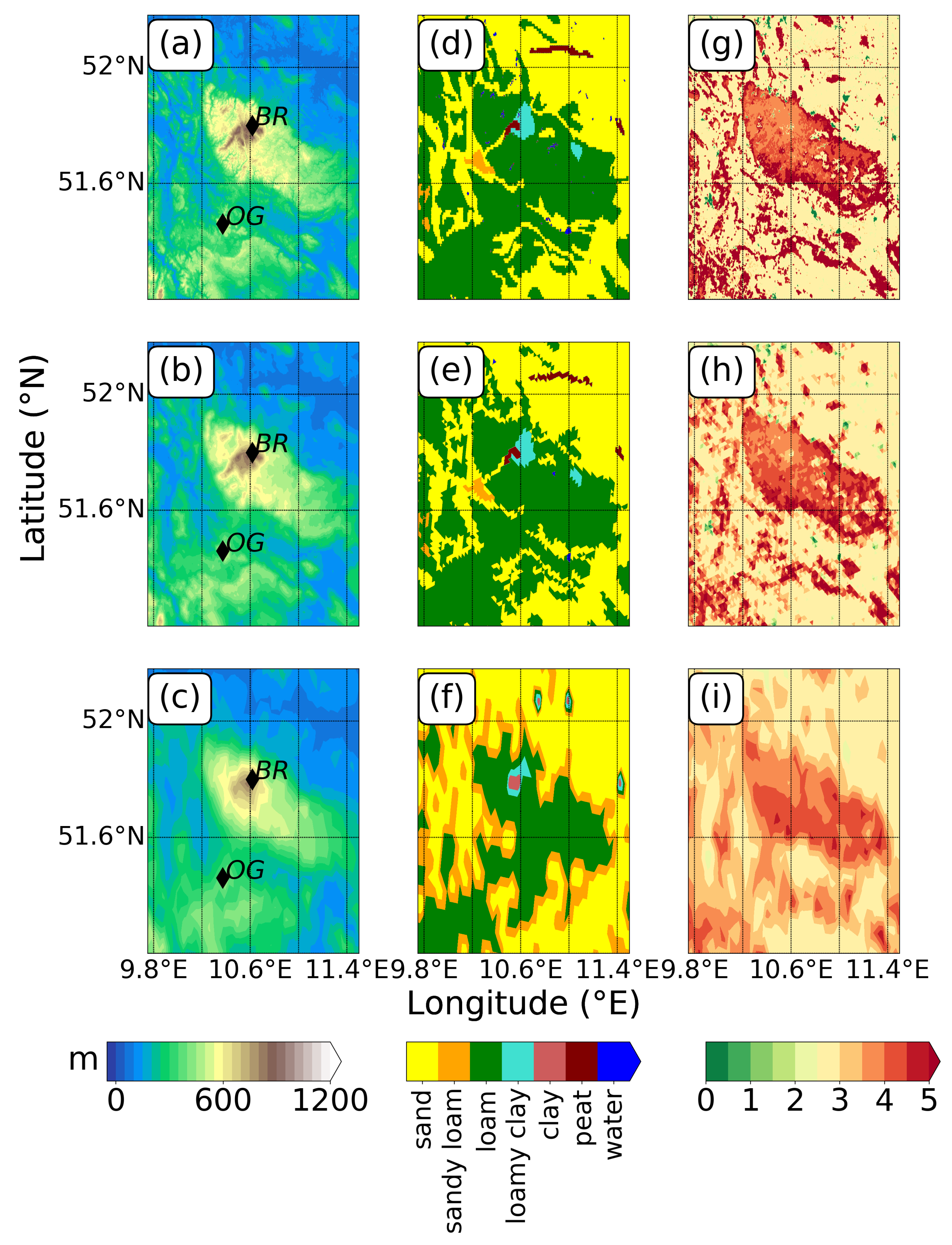
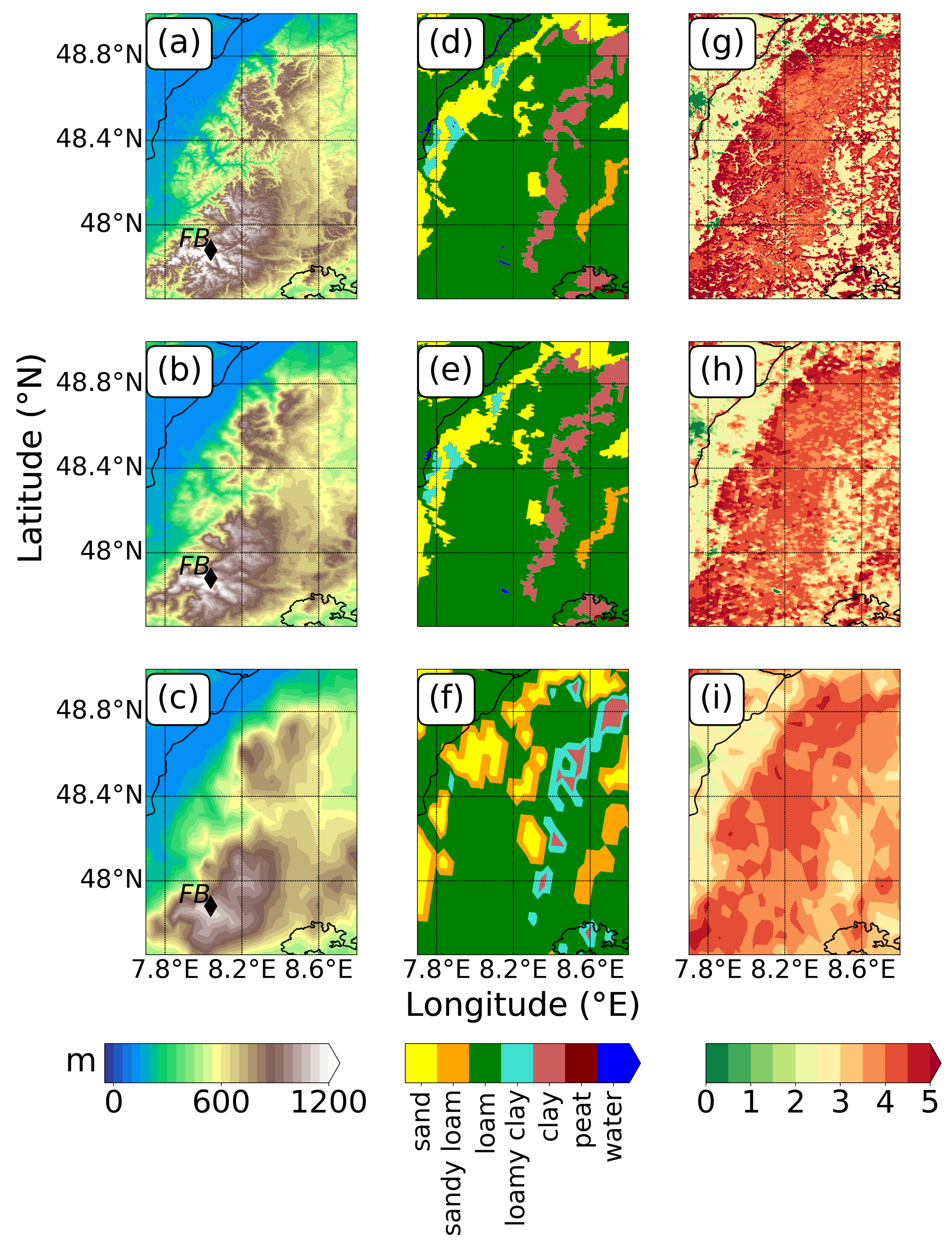
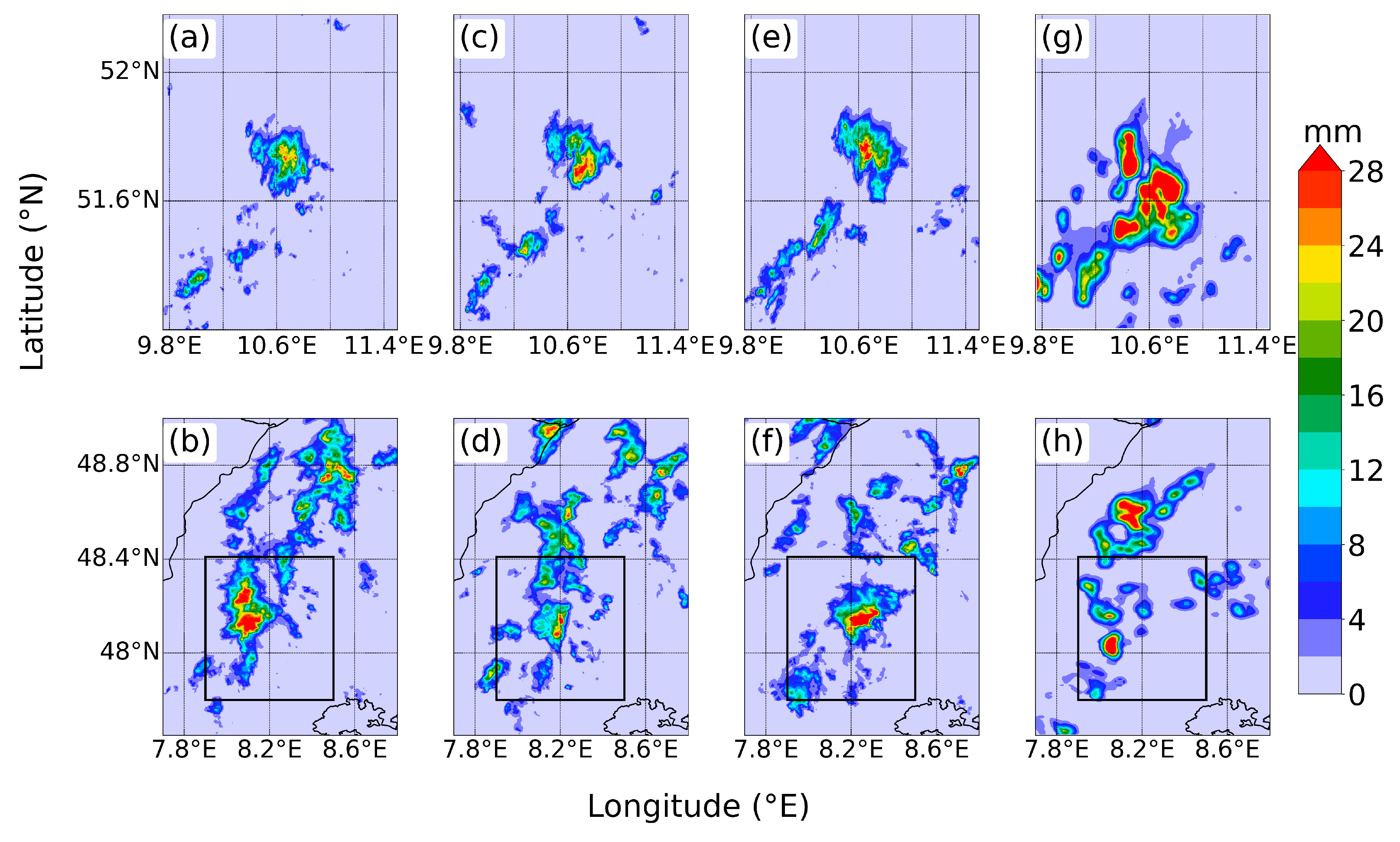
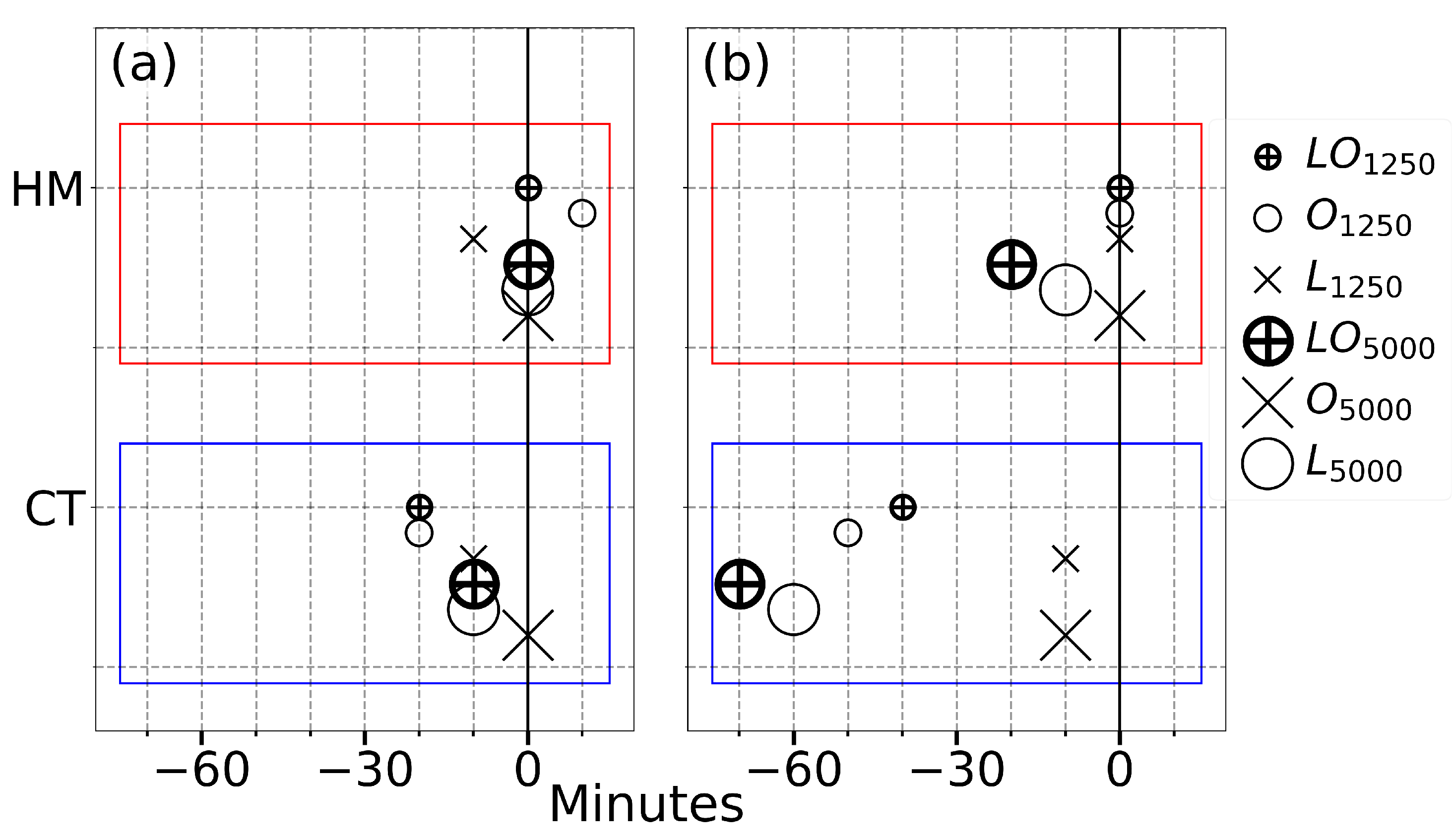
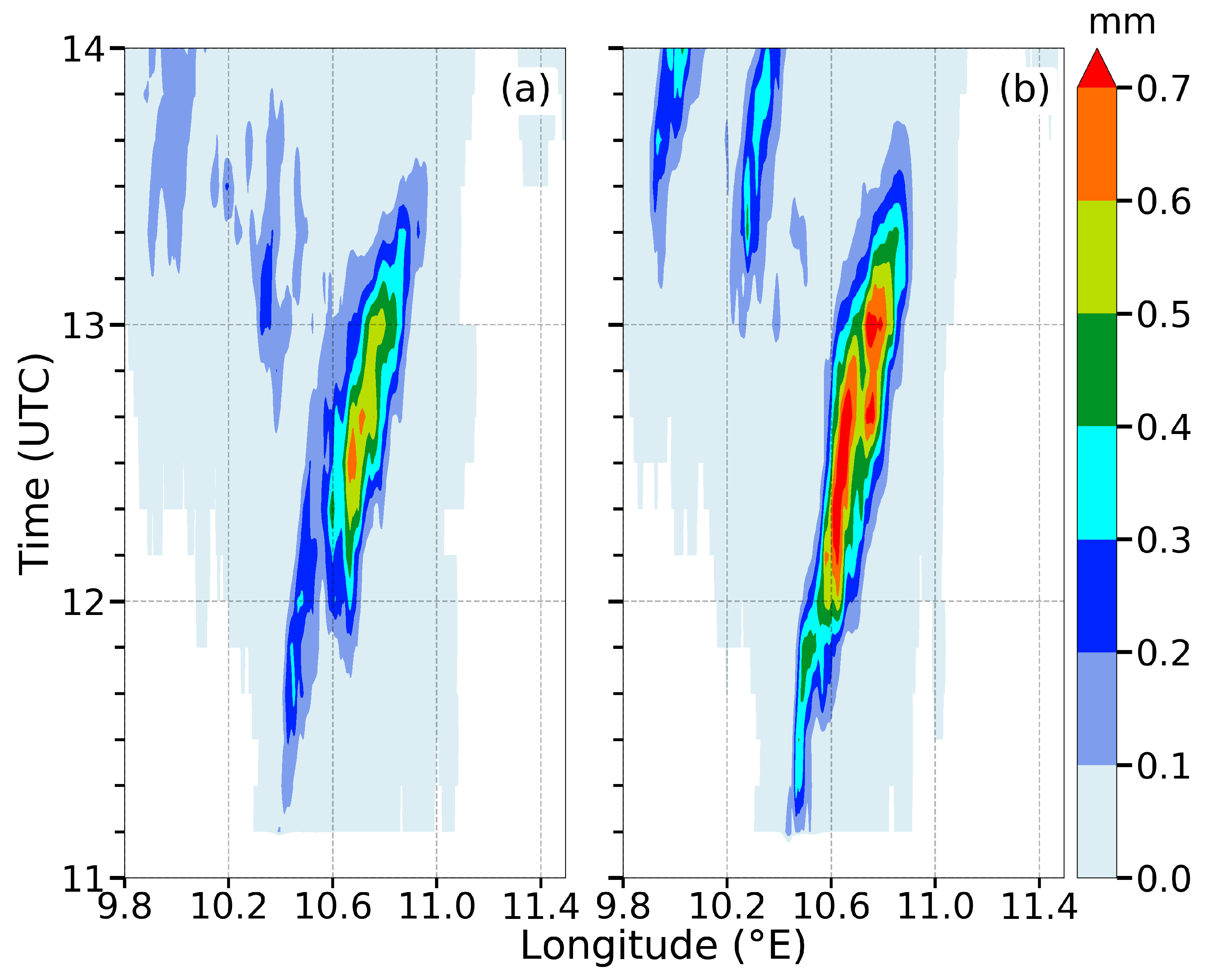
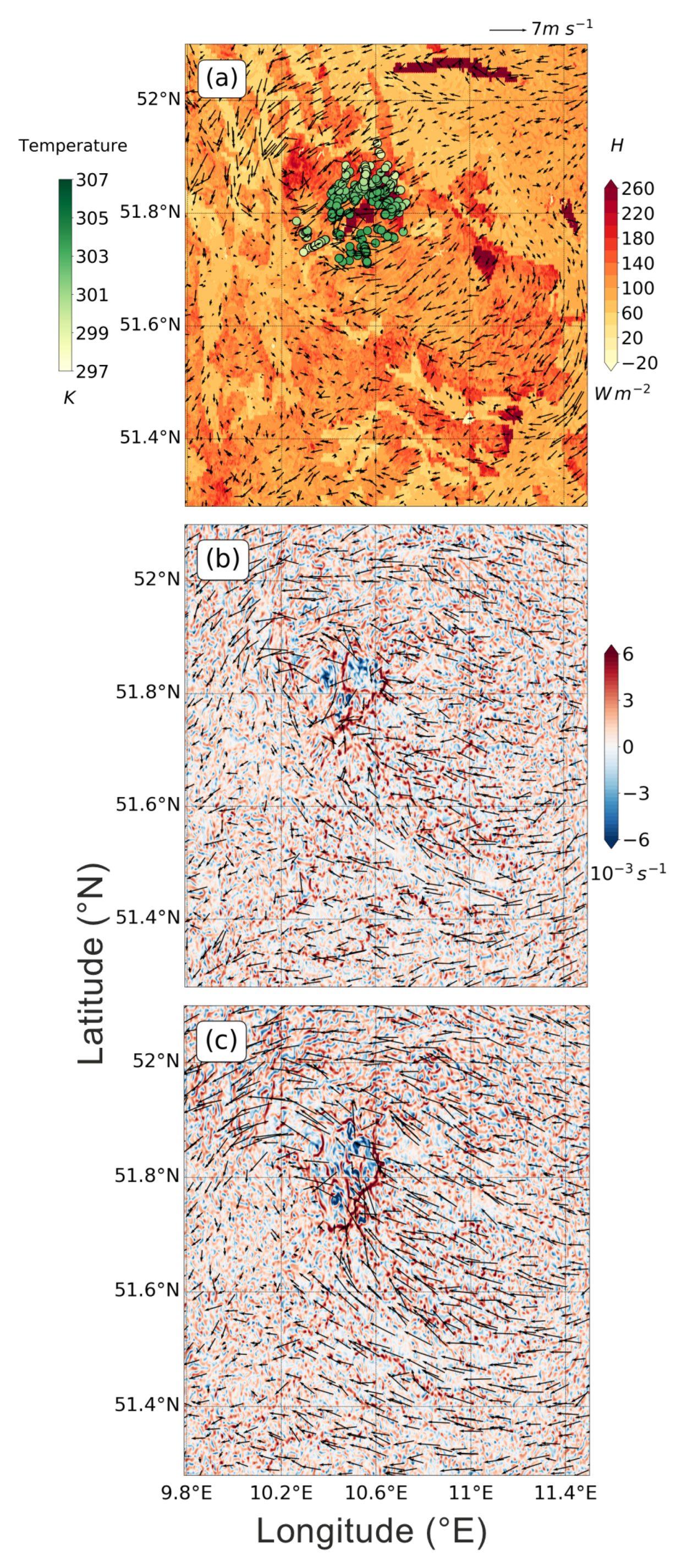
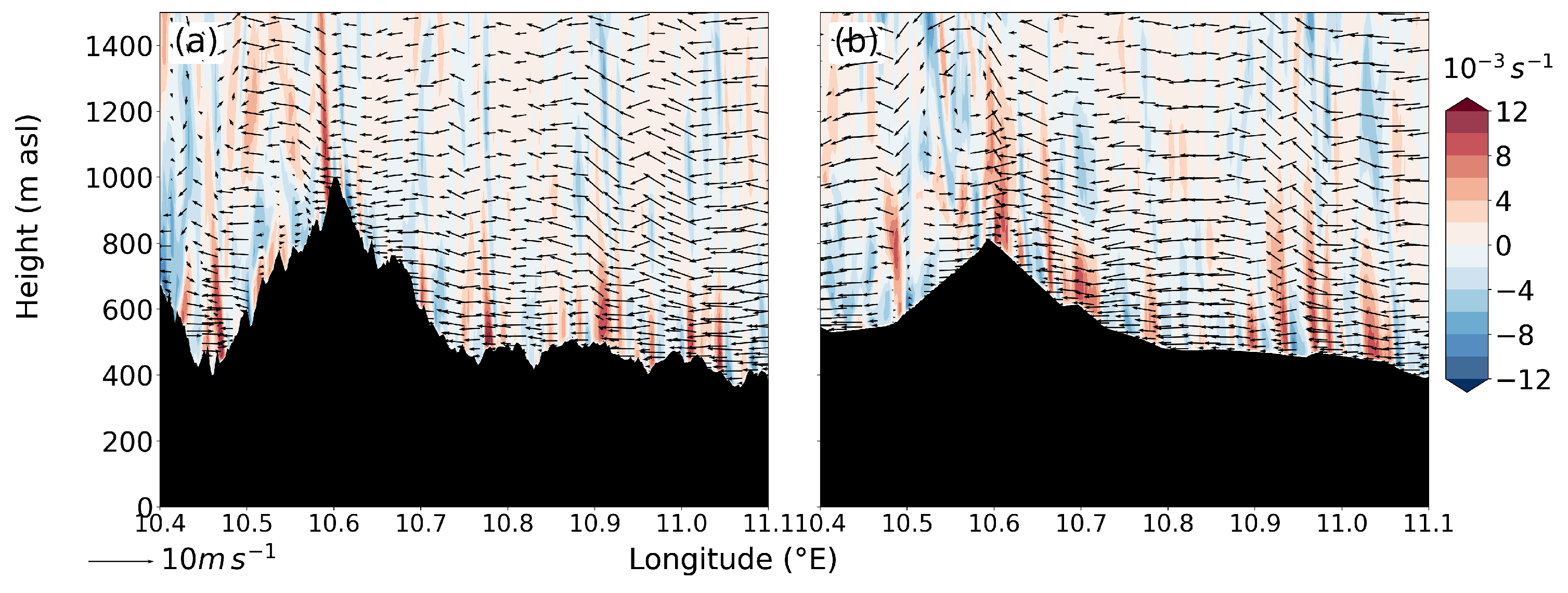

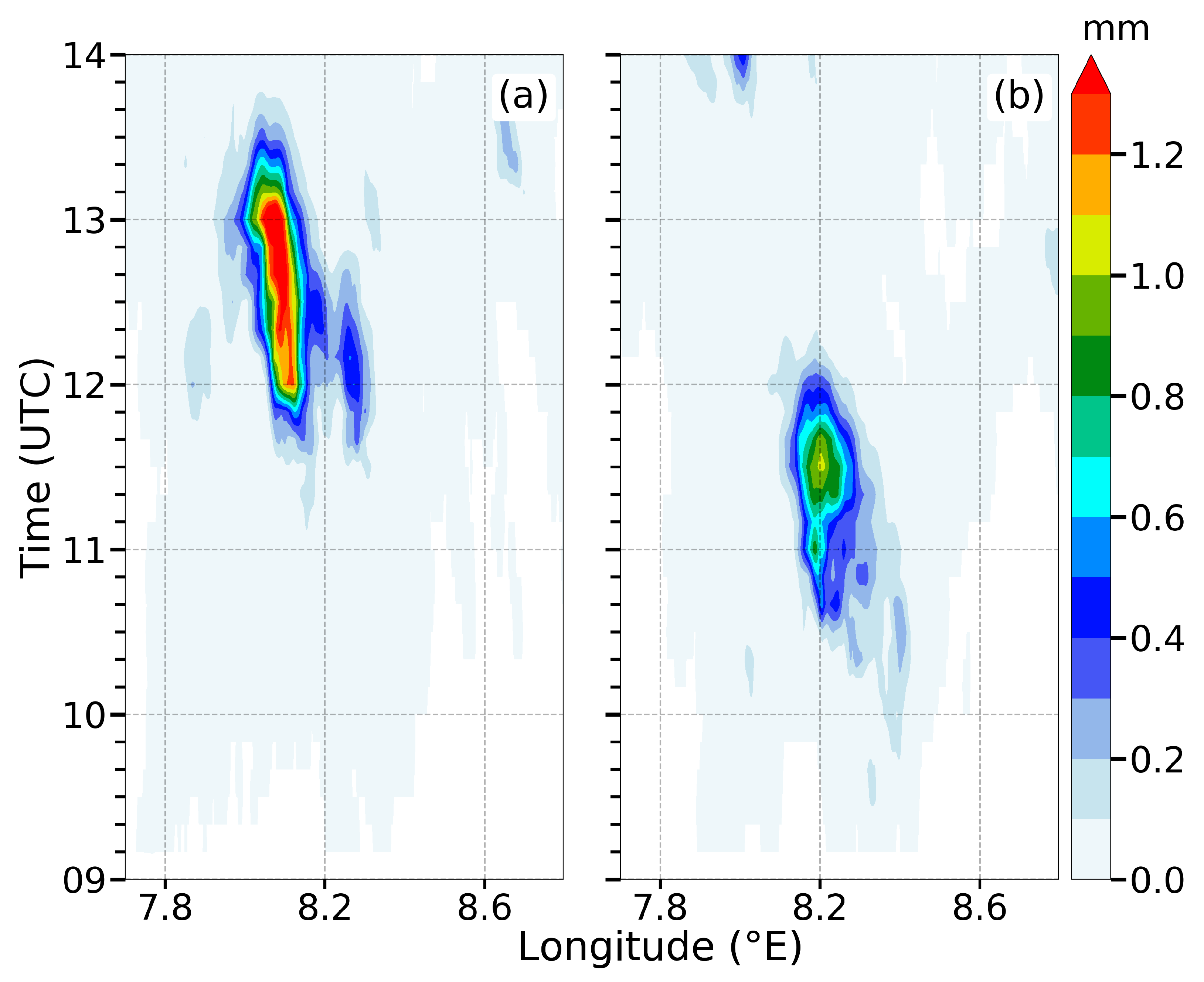
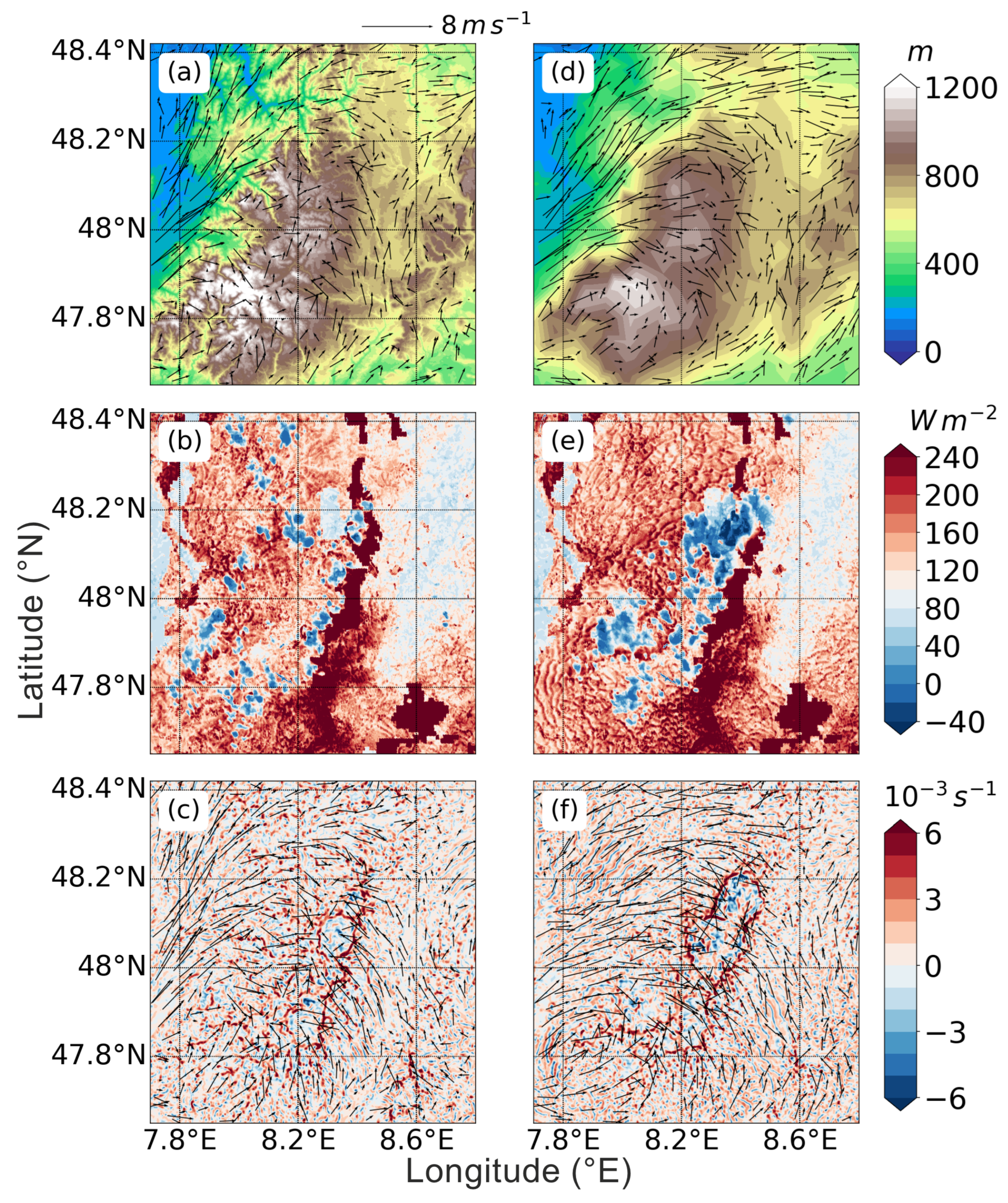
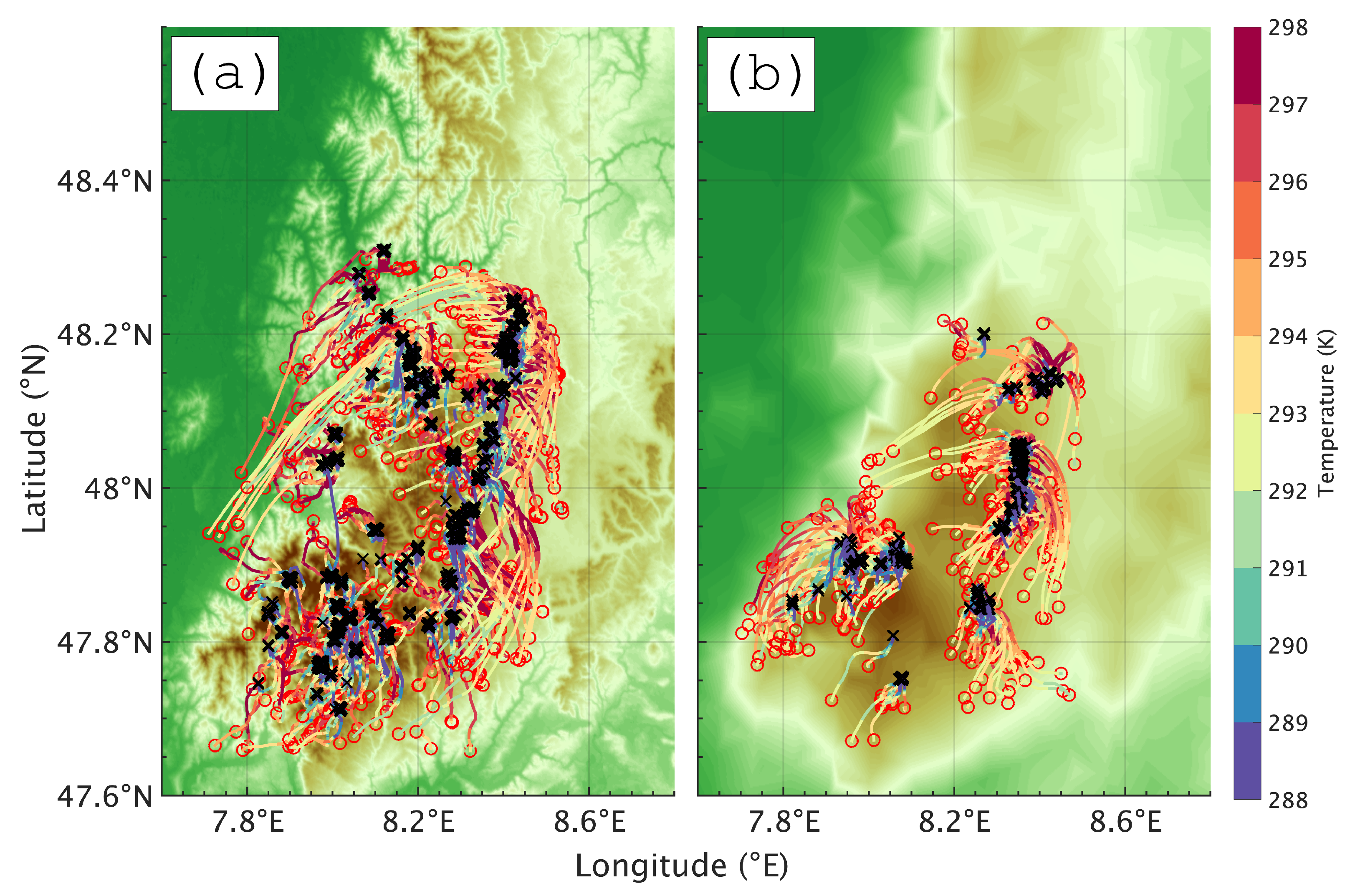
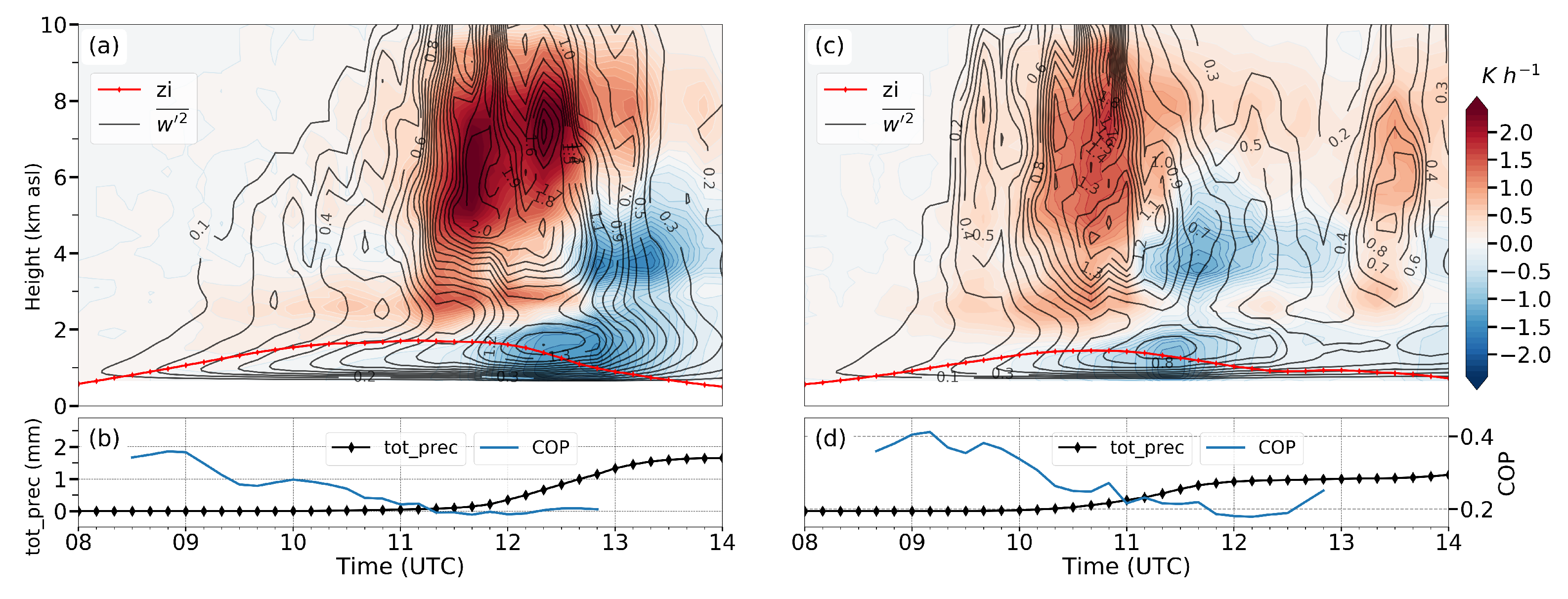

| Cases | |||||||
|---|---|---|---|---|---|---|---|
| HM (9 June 2018) | 0.91 | 0.92 | 0.99 | 0.95 | 1.06 | 0.94 | 1.14 |
| CT (29 May 2017) | 2.03 | 1.93 | 1.83 | 1.89 | 1.68 | 1.72 | 1.81 |
Publisher’s Note: MDPI stays neutral with regard to jurisdictional claims in published maps and institutional affiliations. |
© 2022 by the authors. Licensee MDPI, Basel, Switzerland. This article is an open access article distributed under the terms and conditions of the Creative Commons Attribution (CC BY) license (https://creativecommons.org/licenses/by/4.0/).
Share and Cite
Singh, S.; Kalthoff, N. Process Studies of the Impact of Land-Surface Resolution on Convective Precipitation Based on High-Resolution ICON Simulations. Meteorology 2022, 1, 254-273. https://doi.org/10.3390/meteorology1030017
Singh S, Kalthoff N. Process Studies of the Impact of Land-Surface Resolution on Convective Precipitation Based on High-Resolution ICON Simulations. Meteorology. 2022; 1(3):254-273. https://doi.org/10.3390/meteorology1030017
Chicago/Turabian StyleSingh, Shweta, and Norbert Kalthoff. 2022. "Process Studies of the Impact of Land-Surface Resolution on Convective Precipitation Based on High-Resolution ICON Simulations" Meteorology 1, no. 3: 254-273. https://doi.org/10.3390/meteorology1030017
APA StyleSingh, S., & Kalthoff, N. (2022). Process Studies of the Impact of Land-Surface Resolution on Convective Precipitation Based on High-Resolution ICON Simulations. Meteorology, 1(3), 254-273. https://doi.org/10.3390/meteorology1030017






